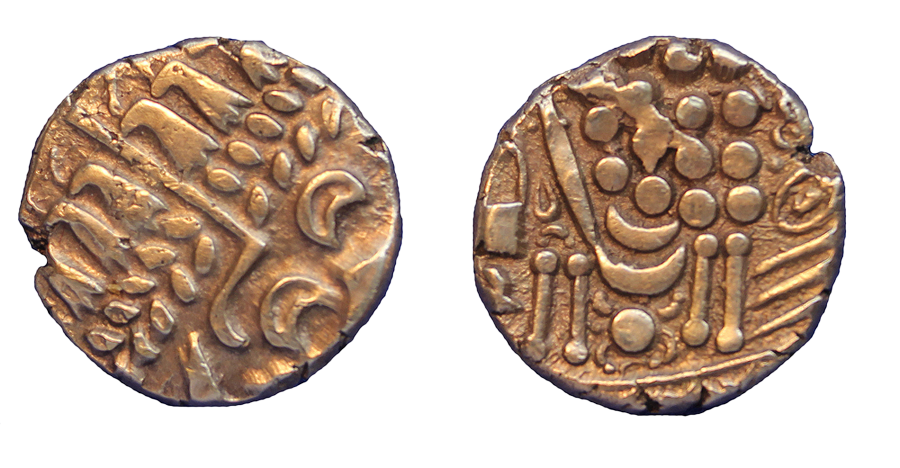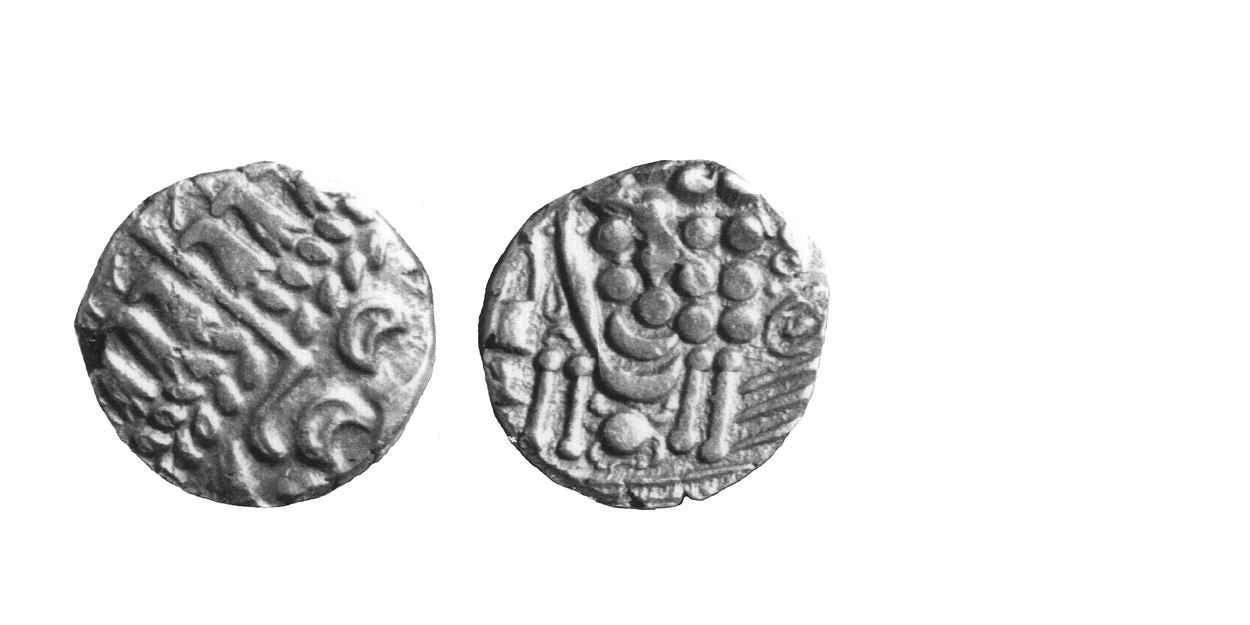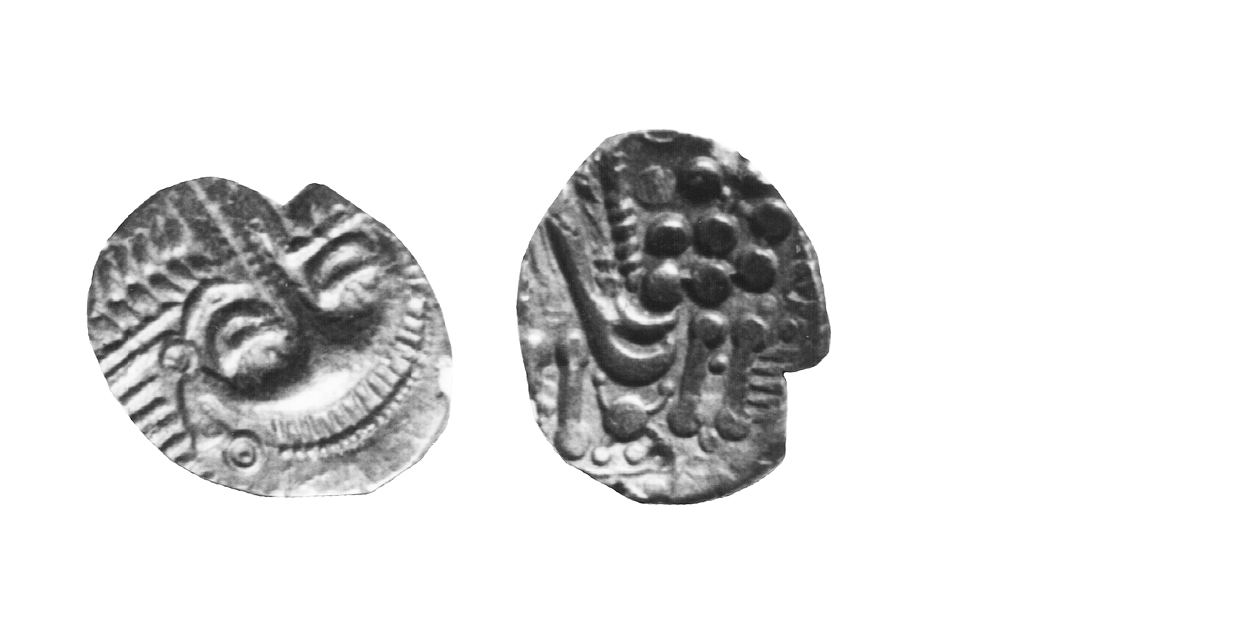
History
Outset of the Gallic War (Info)
Coinage and Trade at the Outset of the Gallic War 60-55 BC.
The Roman occupation of Gaul brought about changes in the trading patterns of the British tribes. The numismatic evidence indicates a fluid situation existed at the outset of the war considerable trading contacts existed amongst the tribes (35). By the close of Caesar's campaigns, however, some of the inter-tribal trading networks had been severed (36). In the years that followed, tribal fortunes hinged upon the allegiances forged during the War.
By 57 BC., the lively cross-Channel trade had created an embryonic exchange network within Britain (37). It supplied luxury items to British markets and located and procured goods required for export to Gaul. The findspots of early imported coins such as the Large Flan and Defaced Die types generally shun the extreme interior of Britain. Evidently, the inland trading network was not sufficiently developed around 100 BC. to require money transactions. However, findspots of later issues, such as the Abstract Design, Westerham North, Westerham South, Chute and North East Coast Types hint at a wider dispersal throughout the interior. Some of the British issues even traveled beyond tribal boundaries in small numbers. While the coins may indicate movement of people within Britain, it is much more likely they delineate inter-tribal trade.
In the early years of the Gallic War, the coins became dispersed farther and farther inland the Gallic War Type circulated in enormous quantities, and well into the Midlands (38). Inter-tribal trade became more articulated and intense, with the Durotrigan territory and the southeast coast acting as two hubs of the networks. This trading situation reached its climax in the early years of the war as Britain became a supply depot for the fight on the Continent.
The appearance of so many Gallic War Type staters in Britain suggests Roman manipulation. By financing one tribal group to compete against another in the trading networks, they may have tried to influence the flow of war materiel to the Continent for Roman benefit. Thus, the Romans may have been the ultimate source of the Atrebatic/Regnan/Belgic gold, but this has not been proven (39).
In any event, the Atrebates/Regni/Belgae appear to have received immense quantities of gold staters and flooded the trading networks with them. Simultaneously, the Durotriges seem to have run out of gold bullion. Their Chute Type stater was replaced first with the Chute/Cheriton Transitional and Cheriton Types around the middle war. All these Durotrigan coins are linked by privy marks: the direction of the laurel leaves and an object near the horse's neck. The Transitional piece has full weight, but reduced gold content, the Cheriton a drastically reduced weight and a further reduction in fineness. Cheritons, unlike other staters, can contain a surprisingly high proportion of tin, It is possible the Durotriges were obtaining Cast Bronzes from Kent and adding them to melted-down Chute staters to debase the alloy. It appears the Durotriges were trying to maintain a gold coinage for trading purposes, but as events turned out, unsuccessfully.
While the Atrebates/Regni/Belgae were engaging in British trade with good-quality staters, the Durotriges found themselves having to deceive their partners with increasingly inferior ones. The networks, eventually detecting the difference, shunned the Durotrigan hub, preferring the Atrebatic/Regnan/Belgic one. Since the Romans were preparing to invade Armorica, they had a strong reason for eliminating the Durotrigan trade with the Continent prior to 56 BC. By financing Atrebatic/Regnan/Belgic trade, making it more competitive in the trading networks, they would have accomplished just this.
Caesar, by smashing the Venetic fleet in 56 BC. and invading Armorica in 57, largely cut the Durotriges off from their Continental sources of luxury goods. This effectively hobbled the Durotriges in the British trading networks, because they now lacked the luxury goods to make barter-type arrangements. Prior to the war, Italian wine, coloured glass, figs and Armorican pottery were being imported into the Durotrigan port, Hengistbury, for redistribution (40). After the war, the profitable Italian wine trade shifted to the Trinovantes/Catuvellauni as findspots of later amphorae show, and the Durotriges were forced to import wine from Spain. They may have lost trading rights for other commodities, as well. Perhaps to compensate for their loss of prestige imports, the Durotriges developed their pottery industry around Poole harbour and Hengistbury served as a distribution centre for trading this commodity.
After the war, Durotrigan coins were limited to the tribal territory and to a small extent that of the Dobunni (41) However, findspots of Atrebatic/Regnan/Belgic coins in Dobunnic territory show the Durotriges had competition for the Dobunnic trade. The Durotriges probably suffered economically from the loss of their trading contacts and the competition from other tribes. Post-war Durotrigan coins became increasingly coarse and debased, suggesting increasing poverty. Although some goods continued to be imported from the Continent, trade was at a reduced level. Economic difficulties, of which we have only a hint, may have been one of the reasons why the tribe was so resolutely opposed to Vespasian during the Claudian invasion a hundred years later – they would have blamed the Romans for their losses.
When Caesar invaded Britain in 55 BC. and again in the following year the situation in the southeast was altered as well. Henceforth, the Romans controlled the cross-channel trade and it appears they manipulated it to favour their allies during the war at the expense of the anti-Roman tribes. Roman manipulation helps explain the wealth of the post-war Atrebatic/Regnan/Belgic and Trinovantian/Catuvellaunian coinages, compared to the surprisingly small output of the Cantii. The small postwar output of the Cantian mint and the earlier appearance of Kentish Cast Bronzes in Durotrigan territory may not be mere coincidence the Cantii may have suffered repression in the cross-Channel trade after the war.
Next section: The Caesarean Invasions


